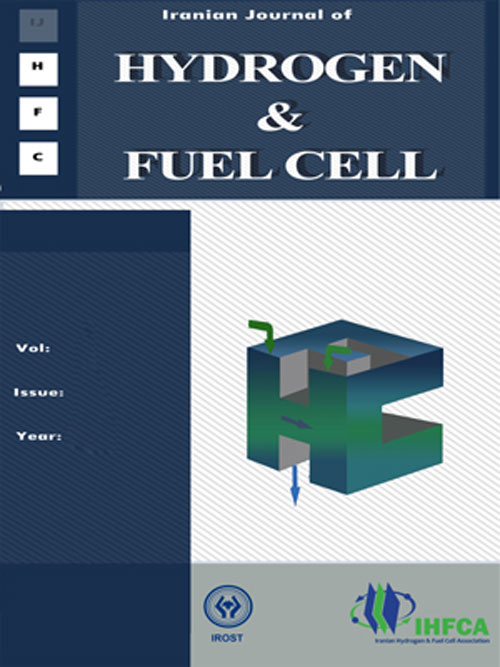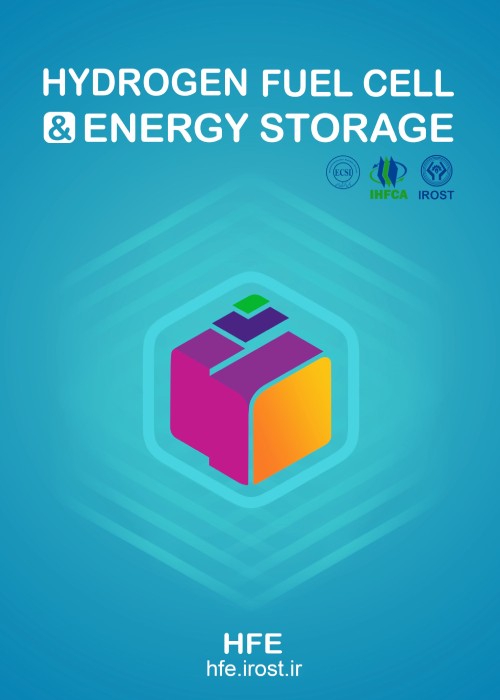فهرست مطالب

Journal of Hydrogen, Fuel Cell and Energy Storage
Volume:3 Issue: 1, Winter 2016
- تاریخ انتشار: 1395/07/27
- تعداد عناوین: 6
-
-
Pages 1-10Effect of clamping pressure on electrical resistance between Gas diffusion layer (GDL) and bipolar plate is a very important parameter in Proton exchange membrane (PEM) fuel cells. For investigation of this matter some researches have been done in these years. But there is not an experimental investigation of clamping pressure effect on PEM electrical resistance. In this paper, some experimental tests have been performed with various clamping pressures in order to find the relationship between clamping pressure and electrical resistance. The same situations have been simulated in Abaqus software and their results have been compared to each other. Some models with different situations of clamping pressure and thickness of end plate for uniform pressure distribution on the gas diffusion layer have been obtained and these models have been investigated for electrical analysis. These models have been imported to electrical and mechanical analysis with putting electrical loads and boundary conditions. At the end, results of the investigation showed that PEM fuel cell with more clamping pressure and end plate thickness has less electrical resistance. Stress and electrical resistance have reversed relationship to each other. In other word by increasing in clamping pressure, electrical resistance between gas diffusion layer and bipolar plate will reduce and vice versa.Keywords: Proton exchange membrane fuel cell, Clamping pressure, Electrical resistance, Uniform pressure
-
Pages 11-17Palladium nanoparticles supported on carbon black powder (Vulcan XC-72) nanocomposite (Pd/C) are synthesized as the catalyst for the anodic oxidation of glucose for use in a direct glucose alkaline fuel cell (DGAFC). Characterization of the catalyst is carried out using physical and electrochemical methods. It is observed that Palladium nanoparticles are uniformly dispersed onto the carbon black powder nanocomposite support. The catalytic properties of the catalyst for glucose electro-oxidation were studied using electrochemical methods such as cyclic voltammetry and chronoamperometry. Cyclic voltammetry shows that this catalysts exhibit high electro catalytic activity for glucose oxidation. Pd/Vulcan XC-72 /glassy carbon electrode exhibits a well-defined catalytic oxidation peak current increasing linearly with an increase in the glucose concentration in rang of 10 mM to 60 mM. Chronoamperometry indicate that Pd/Vulcan XC-72 exhibits a steady state activity for glucose oxidation. Results show that the prepared Pd/Vulcan XC-72 as an effective anodic catalyst toward glucose electro-oxidation. Therefore this electrode is a good candidate for application in direct glucose alkaline fuel cells.Keywords: Direct glucose alkaline fuel cell (DGAFC), Catalyst, Palladium, Glassy carbon electrode (GCE)
-
Pages 19-31In this study, the electrocatalytic activity of the Co@Pt core-shell nanoparticles toward the ethanol oxidation reaction has been investigated by cyclic voltammetry and chronoamperometry in acidic and alkaline media in details. The physicochemical data obtained in alkaline solution are compared to those in acidic solution. The obtained results demonstrate that while in the both media Co@Pt core-shell nanoparticles exhibit a good electrocatalytic performance for ethanol oxidation reaction; in alkaline medium the Co@Pt core-shell catalyst presents more catalytic activity (1.4 times), exchange current densities (about 8 times), electrochemical active surface area (1.2 times) and stability (about 2 times). The effect of some experimental factors such as electrolytes (H2SO4 and NaOH) and ethanol concentrations was studied and optimum conditions were suggested. From these points, we conclude that ethanol oxidation reaction can be improved with an alkaline electrolyte and the oxidation reaction is highly dependent on the pH of electrolyte. These results indicate that the system studied in the present work; Co@Pt core-shell nanoparticles on the carbon-ceramic electrode, is the most promising system for use in alkaline fuel cells.Keywords: Co@Pt nanoparticles, Core, shell, Ethanol, Acidic media, Alkaline media
-
Pages 33-44This paper presents a hierarchical control strategy for heat and electric power control of a building integrating hybrid renewable power sources including photovoltaic, fuel cell and battery energy storage with Plug-in Electric Vehicles (PEV) in smart distribution systems. Because of the controllability of fuel cell power, this power sources plays the main role for providing heat and electric power to zero emission buildings. First, the power flow structure between hybrid power resources is described. To do so, all necessary electrical and thermal equations are investigated. Next, due to the many complexities and uncertainties in this kind of hybrid system, a hybrid supervisory control with an adaptive fuzzy sliding power control strategy is proposed to regulate the amount of requested fuel from a fuel cell power source to produce the electrical power and heat. Then, simulation results are used to demonstrate the effectiveness and capability of the proposed control strategy during different operating conditions in the utility grid. Finally, the performance of the proposed controller is verified using hardware-in-the-loop (HIL) real-time simulations carried out in OPAL-RT technologies for a real building in Tehran. The HIL results show that the proposed controller provides the proper power and heat control strategy.Keywords: Adaptive, Fuzzy Control, Hybrid Power Control Photovoltaic, Fuel Cell, Energy Storage
-
Pages 45-58In this study, effect of energy price on the development of a biomass gasification-solid oxide fuel cell-gas turbine hybrid power plant has been considered. Although, these hybrid systems have been studied based on sustainable approaches, economic aspects, specifically conventional energy prices, which are the principal bottleneck for the development of these new power generators, have attracted little attention by researchers. In the present study, a novel energy system has been considered, a comprehensive economic model has been implemented for the proposed system, and finally effect of energy price on the main economic factors has been investigated. The economic effects of varying energy prices in three different locations (European Union, US and Iran) were evaluated during the cycle life time the proposed system. Estimation of the Internal Rate of Return (IRR) for the three locations, based on current energy prices and economic conditions, indicated that European Union is the most economically justifiable with an IRR value of 18.15% and a payback period value of 5.8 years. In addition, the economic viability of these modern systems will be further enhanced by slight increase of electricity prices in the US; and it might have the best economic gains by reasonable changes in Irans electricity prices.Keywords: Solid Oxide Fuel Cell, Gas Turbine, Biomass Gasification, Economic Modelling, Energy Price
-
Pages 59-71In this paper, Ni/Al and La-Ni/Al catalysts were prepared with a co-impregnation method and employed in carbon dioxide methanation reaction. The catalytic results showed that the catalyst with (10wt.%) of lanthanum and (20wt.%) nickel had the highest activity at low temperatures in CO2 methanation and the La-Ni/Al catalysts changed the reaction path by lowering its activation energy and consequently increased the rate of reaction. Moreover, the kinetic behavior of the bimetallic and monometallic catalysts in the CO2 methanation reaction was investigated as functions of partial pressures of H2 and CO2 in order to determine the changes in the parameters of power-law type rate expression, resulting from the addition second metal to the catalyst and the change in La/Ni ratio. The reaction orders (α and β) and the rate constant (k) were estimated by non-linear regression analysis that minimizing the sum of the squared differences of calculated and experimental CO2 methanation rates. The results showed that the reaction rate is more sensitive to H2 partial pressure than the CO2 partial pressure.Keywords: Methanation, CO2, nickel catalyst, bimetallic catalyst, kinetic behavior


